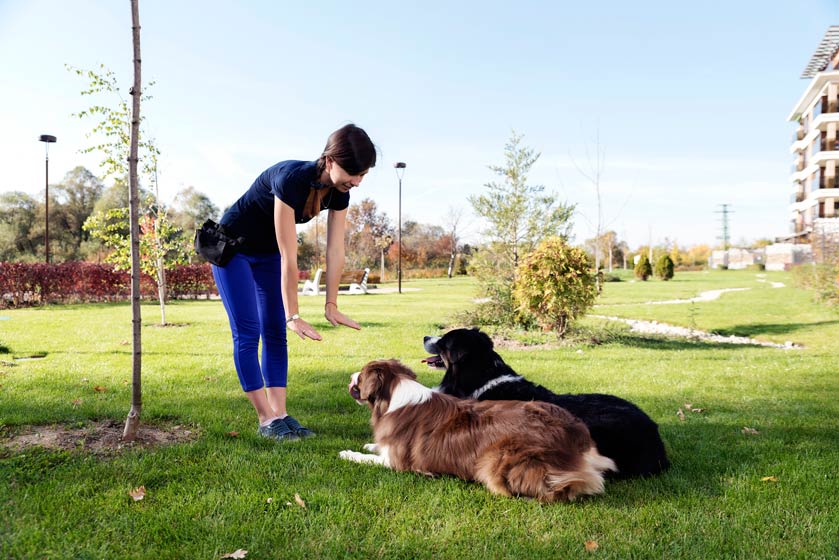What's Positive Reinforcement in Dog Training?

Training is something you'll do on an ongoing basis throughout your dog's life. It's fun, helps bond the two of you, builds your dog's confidence, helps keep him safe, and provides physical and mental exercise.
For your overall dog training philosophy, positive reinforcement with rewards works the best.
What Is Positive Reinforcement in Dog Training?
Reinforcement is something that causes a specific dog behavior to increase. In behavior lingo, positive reinforcement is when you add something to a situation that causes a behavior to increase. The word positive in this arena doesn't necessarily mean the something added is good, like a treat or a reward. It could be something bad, like a swat or a correction for an unwanted behavior. It's positive reinforcement because it is something added that wasn't in the situation before and tends to increase compliance.
In contrast, negative reinforcement, in dog training, means the removal of something from a situation that increases a behavior. It usually means that something the dog doesn't like, such as pain, is applied and then removed when the dog performs the desired behavior.
However, most of the time, in general discussion terms, the term positive reinforcement is used to mean rewarding the behavior you want with something good that the dog likes and ignoring or redirecting behavior you don't want. Using a reward works better in positive reinforcement training than using punishment.
Why Choose Positive Reinforcement with a Reward?
Positive reinforcement works well in dog training. And doing it with a reward instead of punishment works even better. Essentially, this manner of dog training means showing your dog what you want him to do and reinforcing that behavior by giving him positive feedback.
Dogs have evolved alongside humans, and they know that pleasing people means an increased chance of survival. So, they're hardwired to want to do what their humans wish. They just need to understand what that is. And reward-based training works best for getting it done.
How to Do Positive Reinforcement Dog Training with a Reward
Here are some general tips for getting the most out of your dog training time:
- Keep sessions short. Shoot for 10 to 20-minute training sessions depending on your dog's age and concentration abilities.
- Do a play session first. If you allow your dog an enjoyable romp before you get down to business, he should be able to concentrate better on training.
- Work on an empty stomach. If your dog's a little bit hungry, treat-based rewards may have more impact.
- Stay positive. If you find yourself feeling frustrated, it's best to end the session and try again later. Your dog is susceptible to your moods, and your negative feelings may have a detrimental impact on his learning ability.
- End on a high note. Try to end on a high note, allowing your dog to have some success and a reward, even if it's for something he learned previously rather than mastery of the new skill you were practicing. That will make him more interested in the next training session.
What Types of Rewards Work Well for Dog Training?
Many dogs are highly food-oriented, so treats usually work well. Use something of high value, which means it's something your dog really, really likes. Of course, break it into as small of pieces as you can because you don't want to give him too many calories.
Praise is also a tremendous reward for dogs, so use it as a reward during dog training whenever possible.
A little game with a favorite toy, such as tug, fetch, or wrestling can be a fantastic reward for dogs that are motivated by play and attention.
Clicker training is a powerful training method for many dogs. This type of positive reinforcement uses a sound to tell the dog he's on the right track. You can click much faster than you can give any other kind of reward, so it's easier to help the dog understand what you want when you're using a clicker. You can add another reward after the click if you need to. Learn more: "Clicker Training for Dogs: An Overview."
You May Also Like These Articles:
Clicker Training for Dogs: An Overview
3 Commands That Could Save Your Dog's Life
10 Ways to Keep a Dog Busy Inside
Disclaimer: This website is not intended to replace professional consultation, diagnosis, or treatment by a licensed veterinarian. If you require any veterinary related advice, contact your veterinarian promptly. Information at DogHealth.com is exclusively of a general reference nature. Do not disregard veterinary advice or delay treatment as a result of accessing information at this site. Just Answer is an external service not affiliated with DogHealth.com.
Notice: Ask-a-Vet is an affiliated service for those who wish to speak with a veterinary professional about their pet's specific condition. Initially, a bot will ask questions to determine the general nature of your concern. Then, you will be transferred to a human. There is a charge for the service if you choose to connect to a veterinarian. Ask-a-Vet is not manned by the staff or owners of DogHealth.com, and the advice given should not delay or replace a visit to your veterinarian.



